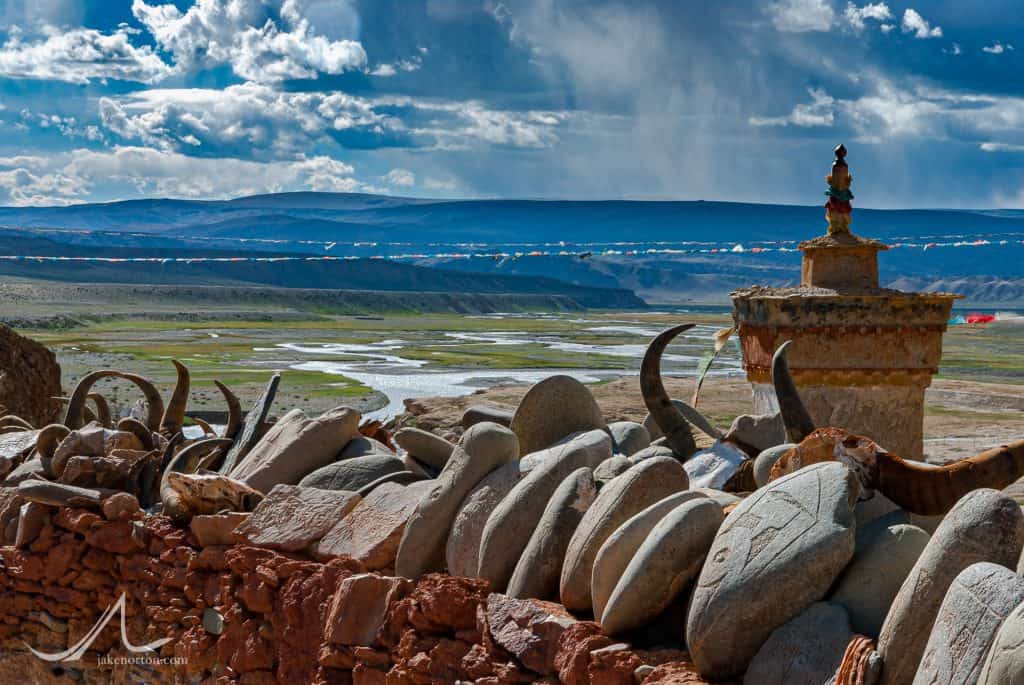Note: This is the first of what will be a regular Monday post here on the unDefined Blog called "Moments, Memories, Mountains." This series will be short and sweet, focused on taking us on a short journey - in image and word - to a faraway place...Something many of us are longing for during these times. Have a place you're dreaming of, wanting to know more about, or would like to hear stories from? Leave a comment below and tell me about it and I'll try to write about it in a future Moments, Memories, Mountains post!
As we rumbled along in our Land Cruisers, I braced myself for another long day bumping across a barren landscape. While beautiful in its austerity, jeeping across the Tibetan Plateau is arduous: Jolting back and forth, trying not to smash your seatmate, is a full body, nonstop workout. Add in the dust - snake-like tendrils of fine powder which penetrate even the most tightly sealed window, covering everything - camera lens to cornea - in a fine film of silt - and an 8-hour drive can quickly be an exercise in suffering.
We had just come from a sacred kora, or circumambulation, of Mount Kailash, the holiest of holies, most sacred of sacred peaks, revered by Hindus and Buddhists alike. The three-day hike around the mountain was part one of our acclimatization in Western Tibet before climbing Gurla Mandhata, a 7694-meter peak south of Kailash. After days of walking from Nepal and around Kailash, the jeeps were both welcome and tortuous.

Several hours before, we departed Tirthapuri, a beautiful and sacred spot along the Langqen Zangbo (Sutlej) River. Believed to be a place of devotion and meditation by Guru Rinpoche (Padmasambhava) and his consort, Yeshe Tsogyal (the "Victorious Ocean of Knowledge"), Tirthapuri is the third stop of a full Kailash pilgrimage: first a kora of Lake Manasarovar, then a kora of Kailash, and finally a visit to Tirthapuri if for no other reason than to soak your feet in the hot springs there.

The driving was bumpy, the landscape monotonous, the dust incessant, relentless. But soon, the engine began to strain, the grade increasing as we climbed up a rise to nearly 16,000 feet. Dusty, barren plains gave way to verdant valleys, a kaleidoscope of color that seemed impossible after all the browns and beiges of the preceding days.
Far below us was the Langqen Zangbo, as the Sutlej River is known in Tibet. Beginning as a trickle in the mountains west of Raksas Tal, by Tirthapuri the Langqen is a full-fledged, raging Himalayan river, its silted waters carving canyons and carrying nutrients from the plateau to the Ingo-Gangetic Plains. It flows some 300 kilometers as the Langqen, and then at Shikpi Pass it flows into Himachal Pradesh, India, and becomes the Sutlej, eventually joining the Indus River near Bahawalpur in Pakistan.

A quiet river, receiving none of the fanfare and celebration of its Plateau-borne kin like Yarlung-Tsangpo, Mekong, Indus, and Salween, the Langqen-Sutlej nevertheless has seen and influenced its share of history: Its banks were the home and history of the Zhangzhung Kingdom of ancient, pre-Buddhist Tibet. Later, the Langqen quenched the thirst of the Guge Kingdom at Tsaparang, and there's evidence to suggest it was - before severe tectonic activity of 1700 BCE - part of the Ghaggar-Hakra River, believed to be the legendary Sarasvati River that joins the Yamuna and Ganges at Allahabad.
And, today, as it courses through the plains of western Tibet, it provides some respite from the dust, contrast to the geography, and adds beauty to the landscape of this wild realm.



🙏My desire for travel is bubbling like boiling water in a pot. Thank you.
Mine, too, Denisa! Can't wait for the time we can all get out and experience our world again. Until then, we'll have to enjoy doing it virtually! Be well, and see you soon! 🙏
Great work man..i was studying about satluj river and reached here.. satluj river is looking more beautiful in Tibetan barren mountain then himachal beautiful green forest 💐
Hello I am from Australia and have back packed for the last 20 years around the world. This will be my second visit to Tibet. I did not get to do Mt. Kaliash and the western / north western side. Although recently I did the Sutlej river region in Kinnaur I would have loved to be able like many to cross the border into Tibet there. Wouldn't that be wonderful hehehe. However it is not and I will be coming from Katmandu. I thank you for your wonderfully written article and photos of a region I have desired to go into for many years and it is so inspiring. I am a person that like to travel off the beaten path for my research of transmigratory path of ancient civilisations. Have you any advice how to get a driver that is not going to cost the earth. Can I just do this contact while I am in Katmandu. Is there anyone you can recommend. Thank you so much for your time. Carolyn